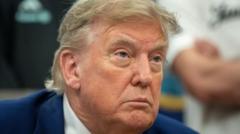Chinese garment factories, long attractive for their low-cost production, are facing a critical juncture as new tariffs imposed by the U.S. hinder their ability to compete in the American market.
**China's Garment Industry at a Crossroads Amidst Increased Tariffs**

**China's Garment Industry at a Crossroads Amidst Increased Tariffs**
As U.S. tariffs reshape the landscape, Chinese apparel manufacturers scramble for survival.
In the bustling garment district of Guangzhou, Liu Miao is feeling the brunt of these changes. For five years, he thrived selling to wholesale buyers in the U.S. through e-commerce platforms like Amazon. However, the recent end of a U.S. tax loophole and the advent of new tariffs on inexpensive imports have severely diminished his profits, forcing him to rethink his business strategy amidst this turbulent economic climate.
Liu, who owns a small factory located in one of China’s core garment manufacturing hubs, recently shared that he could no longer sustain his previous profit margins. With tariffs skyrocketing, his earnings have plummeted from $1 per garment to a mere 50 cents. Although he contemplated reducing employee wages, he ultimately refrained as many workers in the crowded labor market were already facing uncertainty amidst the ongoing economic shifts.
The boom of e-commerce facilitated rapid growth for Chinese manufacturers. Platforms like Shein and Temu provided direct access to American consumers, allowing small factories to flourish. For years, packages valued under $800 could enter the U.S. tax-free, enabling competitive pricing which drove Chinese exports—a critical pillar of national economic growth.
However, like a tightrope walker teetering on a thin line, the tensions between the United States and China threaten this delicate balance, leading many in Guangzhou to confront a grim reality where the favorable conditions of the past seem to evaporate. As tariffs and global trade policies evolve, the prospects for Liu and his counterparts remain uncertain, underscoring the challenges faced by an industry at a pivotal moment in history.
Liu, who owns a small factory located in one of China’s core garment manufacturing hubs, recently shared that he could no longer sustain his previous profit margins. With tariffs skyrocketing, his earnings have plummeted from $1 per garment to a mere 50 cents. Although he contemplated reducing employee wages, he ultimately refrained as many workers in the crowded labor market were already facing uncertainty amidst the ongoing economic shifts.
The boom of e-commerce facilitated rapid growth for Chinese manufacturers. Platforms like Shein and Temu provided direct access to American consumers, allowing small factories to flourish. For years, packages valued under $800 could enter the U.S. tax-free, enabling competitive pricing which drove Chinese exports—a critical pillar of national economic growth.
However, like a tightrope walker teetering on a thin line, the tensions between the United States and China threaten this delicate balance, leading many in Guangzhou to confront a grim reality where the favorable conditions of the past seem to evaporate. As tariffs and global trade policies evolve, the prospects for Liu and his counterparts remain uncertain, underscoring the challenges faced by an industry at a pivotal moment in history.




















